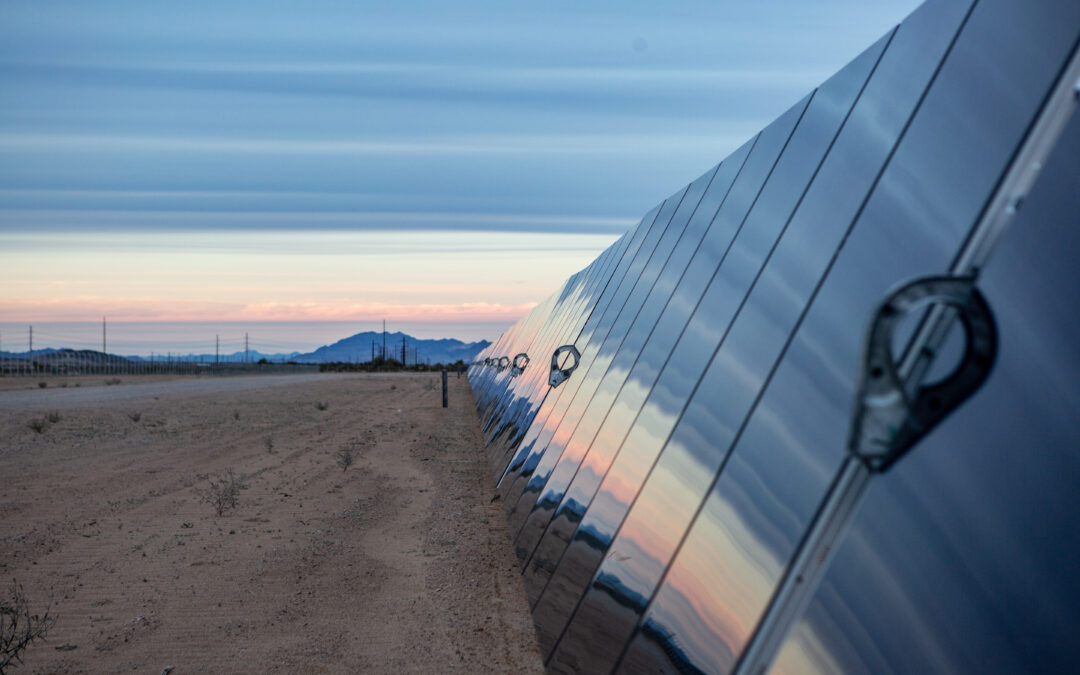By Sheldon Kimber, Founder & CEO, Intersect Power
Shadows on The Cave Wall: The Hard Truths of Solar’s Future
We live in a world where reality is increasingly defined by the information we have access to. While we have never had more information, we have never been less able to establish the veracity of that information. It seems like a new and dangerous world exposed to the murkiness of truth vs. information, but it’s actually something humanity has wrestled with for thousands of years.
Plato’s Allegory of the Cave is a famous philosophical metaphor found in The Republic. In it he lays out a world in which prisoners are chained to a wall only able to perceive what is right in front of them, never knowing anything but that reality. From behind them there is a light projecting the shadows of objects on the wall. The shadows, not the actual objects themselves are all they ever know. In this state of murky and indistinct information the scenes that play out on the wall are the only truth they have.
The allegory goes well beyond this simple observation. I am no philosopher, but it is this commentary on the access to information, the desire to believe certain things and the incomplete perception of truth that I think contains a useful lens for thinking about one of the most broadly discussed topics in clean energy over the past decade – the decline in the cost of solar photovoltaic (PV) modules.
PV modules are one of the fastest-growing sources of renewable energy in the world. According to the International Renewable Energy Agency (IRENA), the global installed capacity of solar PV increased from 40 GW in 2010 to 580 GW in 2019, representing a compound annual growth rate of 28%. The cost of solar PV has also declined dramatically over the same period, making it more competitive with conventional sources of electricity generation. IRENA estimates that the global weighted average levelized cost of electricity (LCOE) from solar PV decreased by 82% between 2010 and 2019, from $0.378/kWh to $0.068/kWh.
It is a feel-good narrative for those who can only see the shadows on the cave wall that these cost declines are the product of some Silicon Valley technological leap forward, a Moore’s Law for energy equipment. While that is true to an extent, not all declines can be attributed to technology improvements.
There is overwhelming evidence that a significant portion of the cost reduction was driven by Chinese subsidization and anticompetitive practices in the solar industry, especially in the upstream segments of the value chain, such as polysilicon, ingots, wafers, and cells. China has emerged as the dominant player in the global solar market, accounting for about 70% of the world’s solar module production and more than 90% of the world’s polysilicon production in 2019. China’s rise in the solar industry was facilitated by a combination of factors, including subsidies, forced labor, lax environmental standards, and predatory pricing.
The Chinese government has provided various forms of direct and indirect subsidies to its solar industry, such as low-interest loans, tax breaks, land grants, export credits, preferential tariffs, and domestic deployment targets. According to a report by the U.S. International Trade Commission (USITC), China’s subsidies to its solar industry amounted to $30.4 billion between 2011 and 2017, compared to $8.5 billion by the U.S. government over the same period.
More controversial are the accusations of forced labor in the Chinese solar industry, particularly in the Xinjiang region, where most of the global supply of polysilicon is manufactured. According to a report by the Center for Strategic and International Studies (CSIS), China has detained and oppressed millions of Uighur Muslims and other ethnic minorities in internment camps, where they are subjected to “job training” programs that amount to free or low-cost forced labor systems. The report estimates that at least one-fifth of the world’s solar modules have some forced labor in their supply chains.
Lax environmental standards in the Chinese solar industry have enabled lower production costs but also caused significant environmental damage. For example, polysilicon production is a highly energy-intensive and water-intensive process that generates hazardous waste and greenhouse gas emissions. The Chinese PV supply chain consumes up to 20% more energy, much of which is coal fired, emitting 3-4 times more carbon dioxide than the global average. Moreover, many Chinese polysilicon plants have been found to dump toxic waste into rivers and lakes, causing severe water pollution and health risks for local communities.
Finally, there have been many accusations of predatory pricing from the Chinese solar industry, which involves selling products below their cost of production or fair market value in order to drive out competitors and gain market share. According to a report by the U.S. Department of Commerce (USDOC), China’s dumping margins for solar products ranged from 18% to 250% between 2012 and 2020. As a result of China’s predatory pricing, many foreign solar manufacturers such as SunPower, SolarWorld, REC Solar, Q-Cells, Solyndra, and others have been unable to compete.
The impact of China’s subsidization and anticompetitive practices on the cost decline of solar modules can be illustrated by comparing the cost structures of different segments of the value chain across regions. According to a report by BloombergNEF (BNEF), the total module cost for a typical Chinese manufacturer was $0.23/W in Q1 2020, compared to $0.35/W for a typical non-Chinese manufacturer. The main difference was in the upstream segments, where Chinese manufacturers had lower costs for polysilicon ($0.06/W vs $0.08/W), ingots ($0.03/W vs $0.05/W), wafers ($0.08/W vs $0.11/W), and cells ($0.09/W vs $0.12/W). The downstream segment of module assembly had similar costs across regions ($0.04/W vs $0.05/W).
These factors have created distortions and inefficiencies in the global solar market, such as overcapacity, price volatility, trade disputes and unrealistic expectations from capital providers and customers. While cost effective solar modules have been an amazing catalyst for the growth of low carbon energy, increasingly volatile supply chains have had a punishing effect on the credibility of renewable developers and will likely impact availability of capital going forward.
An Industry Addicted to Cost Declines
Beyond the availability of modules, the constant cost declines and overcapacity have created an industry addicted to ever falling module prices. Whole business models for what the industry calls “build and flip” developers have been predicated on these constant cost declines and as they slow or reverse the entire industry from large, mature yieldco businesses to small entrepreneurial developers find themselves at an existential crossroads.
On the customer side, the notion that clean energy from PV was on its way toward being “too cheap to meter” has had a meaningful impact on the price expectations of sustainability focused energy buyers the world over. For many years now it has been possible for large energy buyers to cut carbon emissions while achieving very substantial cost improvements. While that is likely still the case, the extent of those cost improvements has begun to decrease and become far more volatile as trade and labor issues upend the reliability of supply chains.
Perhaps the most important impact of all this downward pressure on cost structure from Chinese made crystalline silicon modules, has been the chilling effect on alternative solar technologies. When I entered the industry in the mid 2000s there were numerous thin film technology companies globally. Today, First Solar remains as the only significant non-crystalline player in the industry. Japanese, Korean, and other companies have largely shuttered or moved their thin film technologies into domestic uses in higher value applications than utility scale solar, but the technology is still there.
Make no mistake there were many reasons that some of these thin film companies failed outside of Chinese pressure on prices. However, innovation and investment has been stifled and the progress that comes of repeated failure in these technologies has been forestalled by the realities of module manufacturing being a zero-margin business for all but the cheapest Chinese producers.
On the supply chain side, not only has the world outside of China largely “forgotten” how to make solar modules, but the actual tools and machinery required to manufacture modules that less than a decade ago was supplied by the likes of Germany and Japan is now almost entirely manufactured in China. The world outside of China is literally losing the technological know-how to manufacture one of the most important pieces of industrial equipment of the next century.
The most disturbing element of our current reality is that we are now left with a dominant technology that relies upon cheap power, cheap labor, lax environmental controls, and limitless cheap capital. The crystalline silicon supply chain requires more facilities with more waste, consumes more energy and requires more labor than a modern thin film supply chain. This is not de facto a condemnation of that technology, but merely an observation of the challenges countries face to manufacture PV and thrive.
Because of this, we may well be setting ourselves on a path to a low carbon energy source dependent on supply chain conditions that no longer exist at the scale they once did. Further, given the concentration risk of the location of this supply chain, we should be very concerned about it as both part of a global industry and as a country.
A Critical Need for Supply Chain Diversification
We must create the incentives and space for new supply chains and technologies to flourish in markets outside of China. We continue to need aggressive industrial policy, reinvigoration of non-crystalline technologies, and limited trade protections.
While such a change in market conditions will inevitably create upheaval in the near-term state of the clean energy industry, it can be done in clear and predictable ways, giving years of warning of upcoming trade or labor guidelines and financial support from the government to absorb the near-term cost increases that the industry and its customers will sustain.
The recent Auxin anti-circumvention case in which the government put off action by several years is a great example of this type of reprieve. The Inflation Reduction Act (IRA) with its ramp up in domestic content requirements and near-term support for American made equipment is another great example of how this policy must be rolled out.
If the past few years have taught us anything it is that costs are not decreasing everywhere in clean energy. This is something the industry and customers are already adjusting to. Clean energy is still one of the cheapest forms of energy capable of competing with many fossil sources. That said, we have willingly cornered ourselves as an industry and a society into a technology and supply chain path that may expose us to some very challenging long term cost increases and supply chain instability. It is time we all took note of this. Lobbying harder or yelling louder about various trade issues cannot undo this mess. Only genuine investment in geopolitically stable supply chains, technological innovation, and energy buyers’ commitment to sustainable long term cost declines over near-term bargains will put us back on firm footing.
Policy makers and companies, globally, are increasingly turning their heads from the shadows on the wall and starting to perceive the less murky, but hard contours of today’s solar module marketplace. The policy, market, and investment changes laid out above are the most direct path to diversifying the world’s PV module supply both by geography and by technology. Without this, I believe we will be stuck in The Cave of a carbon intensive energy sector for many decades to come.
CAVEAT: It is important to state a few things as emphatically as I can in order to forestall several valid and inevitable comments on this blog. First and foremost, there are many Chinese manufacturers who have gone to great lengths to ensure that they employ responsible manufacturing processes and have not engaged in many of the practices cited. At my prior company, we purchased modules from many of these suppliers. Second, I absolutely believe that learning curves and innovation played a huge part in the cost decline of PV in the past few decades. Third, while I believe the recent upheavals in cost expectations have been hugely disruptive to our industry and slowed decarbonization, I can attest to the fact that the clean energy industry is healthy, viable and can meet the cost and environmental needs of large energy customers regardless of these cost impacts. Finally, I believe that globalization has overall been a positive force and has likely brought a billion plus people out of crushing poverty and dramatically raised the standard of living globally. That said, this topic must be recognized and discussed by all of us seriously committed to a world in which clean energy helps deliver us from the gathering climate crisis.
References:
– IRENA (2020). Renewable Power Generation Costs in 2019. https://www.irena.org/publications/2020/Jun/Renewable-Power-Costs-in-2019
– USITC (2018). Crystalline Silicon Photovoltaic Cells (Whether or Not Partially or Fully Assembled into Other Products). https://www.usitc.gov/publications/other/pub5266.pdf
– CSIS (2021). A Dark Spot for the Solar Energy Industry: Forced Labor in Xinjiang. https://www.csis.org/analysis/dark-spot-solar-energy-industry-forced-labor-xinjiang
– First Solar (2021). First Solar to Invest $680 Million in Expanding American Solar Manufacturing Capacity by 3.3 GW. https://investor.firstsolar.com/news/news-details/2021/First-Solar-to-Invest-680m-in-Expanding-American-Solar-Manufacturing-Capacity-by-3.3-GW/default.aspx


